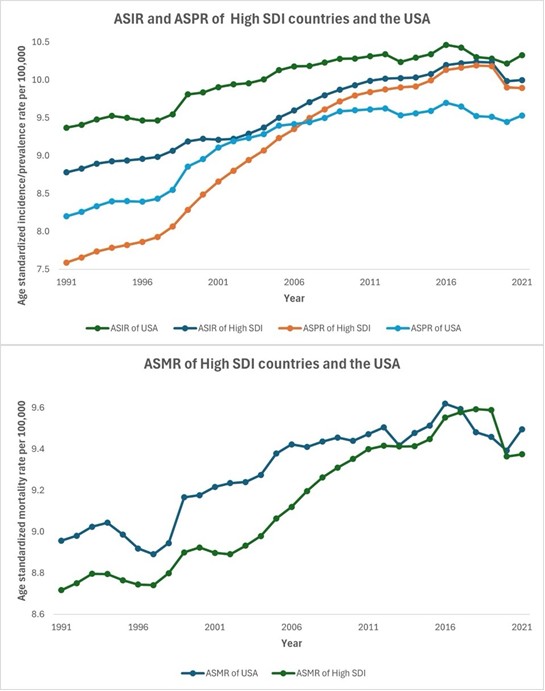Monday Poster Session
Category: Biliary/Pancreas
P2160 - Pancreatic Cancer Trends and Future Projections to 2041: Insights from High SDI Regions and the United States
Monday, October 27, 2025
10:30 AM - 4:00 PM PDT
Location: Exhibit Hall

Kara Eileen Rieth, DO
UNM
Albuquerque, NM
Presenting Author(s)
Muhammad A. Nadeem, MD1, Acacia Shouse, PhD, MA2, Abdul Awan, MBBS3, Kara Eileen. Rieth, DO4, Arshia E. Jahangir, BS5, Fatima Ashfaq, MBBS3, Abhishek Patel, MD6, Niloy Ghosh, MD6, Amir Sohail, MD, MSc2, Abu Baker Sheikh, MD6
1Cleveland Clinic, Cleveland, OH; 2University of New Mexico, Albuquerque, NM; 3Nishtar Medical University, Multan, Punjab, Pakistan; 4UNM, Albuquerque, NM; 5University of New Mexico, Karachi, Sindh, Pakistan; 6University of New Mexico Health Sciences Center, Albuquerque, NM
Introduction: Pancreatic cancer is among the most lethal malignancies, with a five-year survival rate of approximately 10%. Its incidence is rising, particularly in high Socio-Demographic Index (SDI) countries, where it is projected to become a leading cause of cancer-related mortality. This study aims to examine trends in pancreatic cancer incidence, prevalence, and mortality in the United States and other high SDI countries from 1991 to 2021, and to forecast future trends through 2041. Sex-specific differences and regional disparities were also explored.
Methods: This retrospective, population-based observational study utilized data from the Global Burden of Disease (GBD) 2021 database. Primary outcomes included age-standardized incidence (ASIR), prevalence (ASPR), and mortality (ASMR) rates, stratified by sex and region (U.S. vs. high SDI countries). Joinpoint regression analysis was used to calculate annual percentage change (APC) with 95% confidence intervals. Forecast models were generated to estimate trends through 2041.
Results: Between 1991 and 2021, pancreatic cancer rates rose significantly in both the U.S. and high SDI countries, with a major inflection around 2001 and stabilization post-2016. Males consistently exhibited higher rates than females. The U.S. showed slightly higher ASIR, ASPR, and ASMR than high SDI countries, although differences were not statistically significant. Forecasts suggest continued increases in ASIR and ASMR through 2041 across both sexes and regions. Notably, the rate of increase in females, particularly in high SDI countries, is expected to be steeper, though the absolute burden remains higher in males.
Discussion: The increasing and projected burden of pancreatic cancer suggests the influence of modifiable risk factors such as obesity, smoking, alcohol use, and diabetes, beyond aging alone. The observed sex-based and regional patterns call for targeted early detection strategies and prevention initiatives. Future public health efforts should prioritize improved diagnostic methods, risk factor mitigation, and sex-specific interventions to reduce morbidity and mortality associated with pancreatic cancer.

Figure: Age standardized mortality rate of high SDI countries and the USA.
Disclosures:
Muhammad Nadeem indicated no relevant financial relationships.
Acacia Shouse indicated no relevant financial relationships.
Abdul Awan indicated no relevant financial relationships.
Kara Rieth indicated no relevant financial relationships.
Arshia Jahangir indicated no relevant financial relationships.
Fatima Ashfaq indicated no relevant financial relationships.
Abhishek Patel indicated no relevant financial relationships.
Niloy Ghosh indicated no relevant financial relationships.
Amir Sohail indicated no relevant financial relationships.
Abu Baker Sheikh indicated no relevant financial relationships.
Muhammad A. Nadeem, MD1, Acacia Shouse, PhD, MA2, Abdul Awan, MBBS3, Kara Eileen. Rieth, DO4, Arshia E. Jahangir, BS5, Fatima Ashfaq, MBBS3, Abhishek Patel, MD6, Niloy Ghosh, MD6, Amir Sohail, MD, MSc2, Abu Baker Sheikh, MD6. P2160 - Pancreatic Cancer Trends and Future Projections to 2041: Insights from High SDI Regions and the United States, ACG 2025 Annual Scientific Meeting Abstracts. Phoenix, AZ: American College of Gastroenterology.
1Cleveland Clinic, Cleveland, OH; 2University of New Mexico, Albuquerque, NM; 3Nishtar Medical University, Multan, Punjab, Pakistan; 4UNM, Albuquerque, NM; 5University of New Mexico, Karachi, Sindh, Pakistan; 6University of New Mexico Health Sciences Center, Albuquerque, NM
Introduction: Pancreatic cancer is among the most lethal malignancies, with a five-year survival rate of approximately 10%. Its incidence is rising, particularly in high Socio-Demographic Index (SDI) countries, where it is projected to become a leading cause of cancer-related mortality. This study aims to examine trends in pancreatic cancer incidence, prevalence, and mortality in the United States and other high SDI countries from 1991 to 2021, and to forecast future trends through 2041. Sex-specific differences and regional disparities were also explored.
Methods: This retrospective, population-based observational study utilized data from the Global Burden of Disease (GBD) 2021 database. Primary outcomes included age-standardized incidence (ASIR), prevalence (ASPR), and mortality (ASMR) rates, stratified by sex and region (U.S. vs. high SDI countries). Joinpoint regression analysis was used to calculate annual percentage change (APC) with 95% confidence intervals. Forecast models were generated to estimate trends through 2041.
Results: Between 1991 and 2021, pancreatic cancer rates rose significantly in both the U.S. and high SDI countries, with a major inflection around 2001 and stabilization post-2016. Males consistently exhibited higher rates than females. The U.S. showed slightly higher ASIR, ASPR, and ASMR than high SDI countries, although differences were not statistically significant. Forecasts suggest continued increases in ASIR and ASMR through 2041 across both sexes and regions. Notably, the rate of increase in females, particularly in high SDI countries, is expected to be steeper, though the absolute burden remains higher in males.
Discussion: The increasing and projected burden of pancreatic cancer suggests the influence of modifiable risk factors such as obesity, smoking, alcohol use, and diabetes, beyond aging alone. The observed sex-based and regional patterns call for targeted early detection strategies and prevention initiatives. Future public health efforts should prioritize improved diagnostic methods, risk factor mitigation, and sex-specific interventions to reduce morbidity and mortality associated with pancreatic cancer.

Figure: Age standardized mortality rate of high SDI countries and the USA.
Disclosures:
Muhammad Nadeem indicated no relevant financial relationships.
Acacia Shouse indicated no relevant financial relationships.
Abdul Awan indicated no relevant financial relationships.
Kara Rieth indicated no relevant financial relationships.
Arshia Jahangir indicated no relevant financial relationships.
Fatima Ashfaq indicated no relevant financial relationships.
Abhishek Patel indicated no relevant financial relationships.
Niloy Ghosh indicated no relevant financial relationships.
Amir Sohail indicated no relevant financial relationships.
Abu Baker Sheikh indicated no relevant financial relationships.
Muhammad A. Nadeem, MD1, Acacia Shouse, PhD, MA2, Abdul Awan, MBBS3, Kara Eileen. Rieth, DO4, Arshia E. Jahangir, BS5, Fatima Ashfaq, MBBS3, Abhishek Patel, MD6, Niloy Ghosh, MD6, Amir Sohail, MD, MSc2, Abu Baker Sheikh, MD6. P2160 - Pancreatic Cancer Trends and Future Projections to 2041: Insights from High SDI Regions and the United States, ACG 2025 Annual Scientific Meeting Abstracts. Phoenix, AZ: American College of Gastroenterology.
